
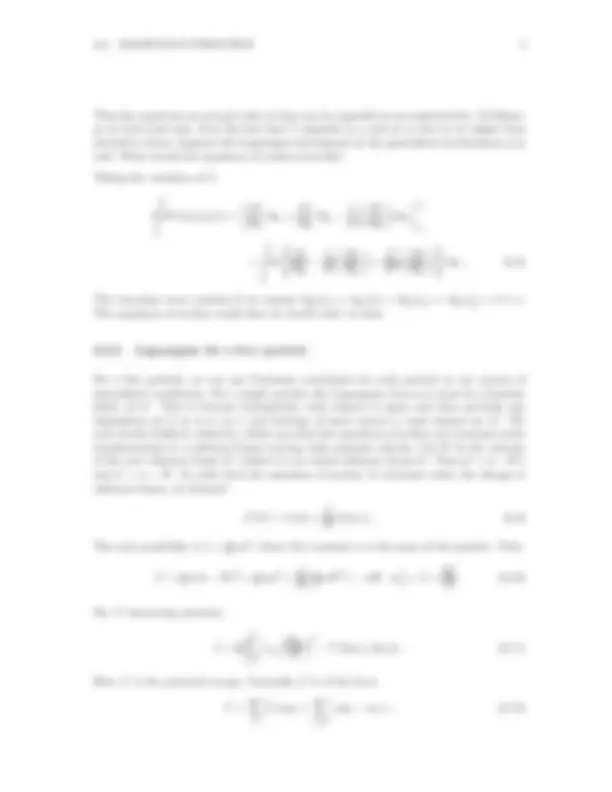
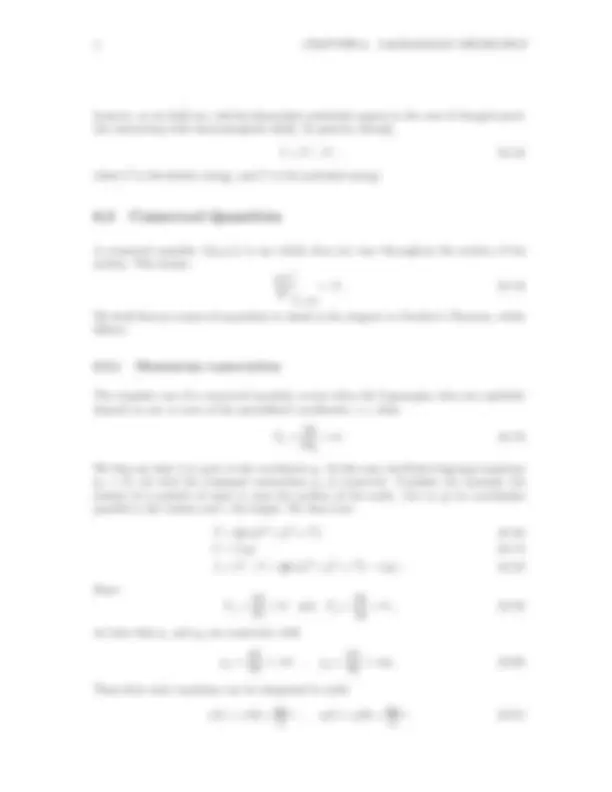
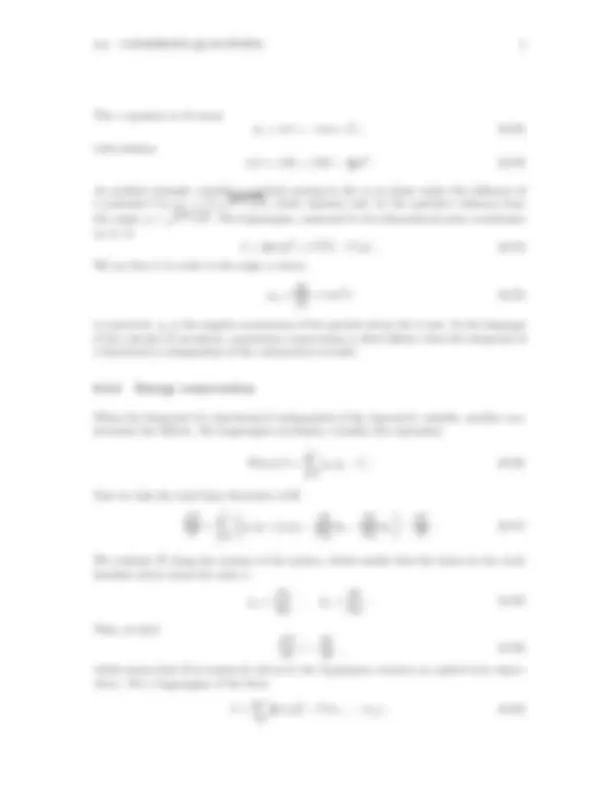
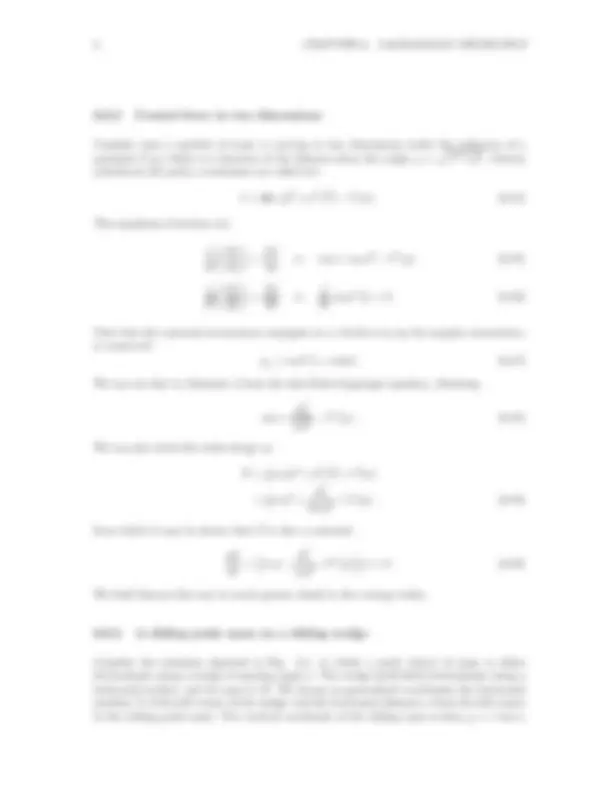
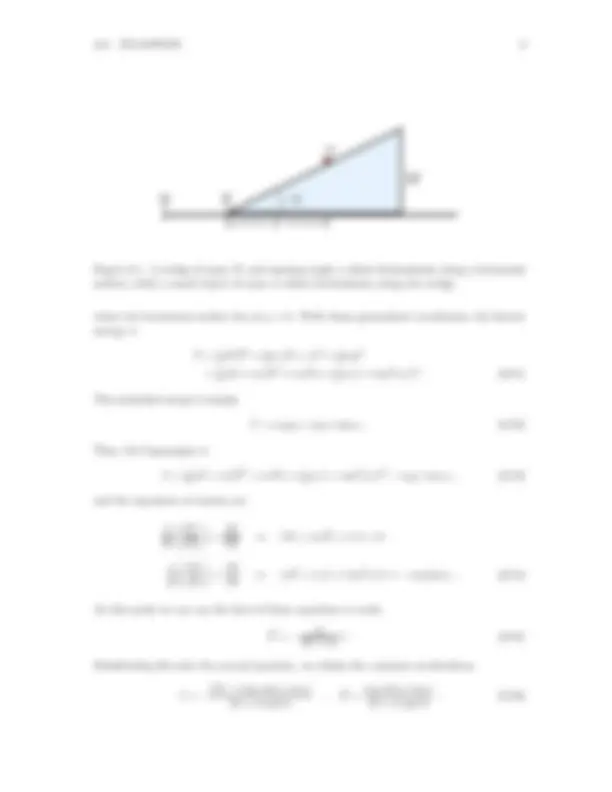
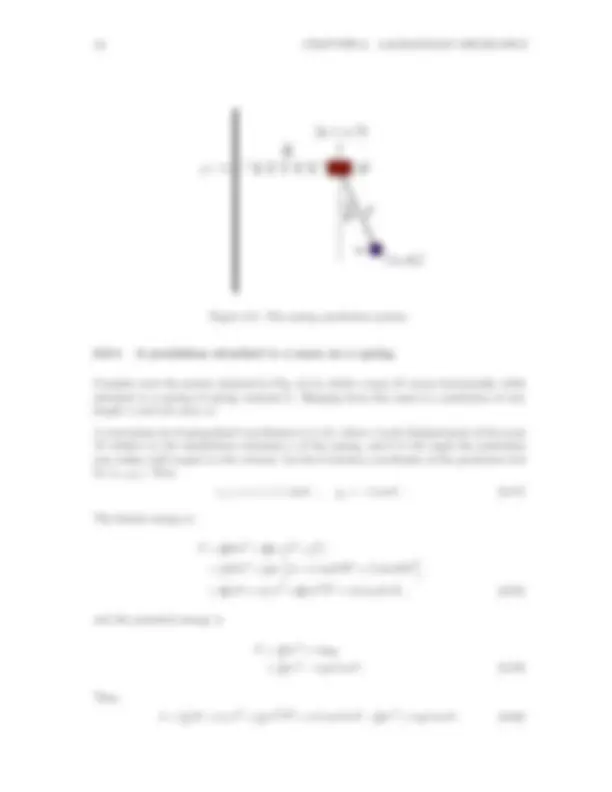
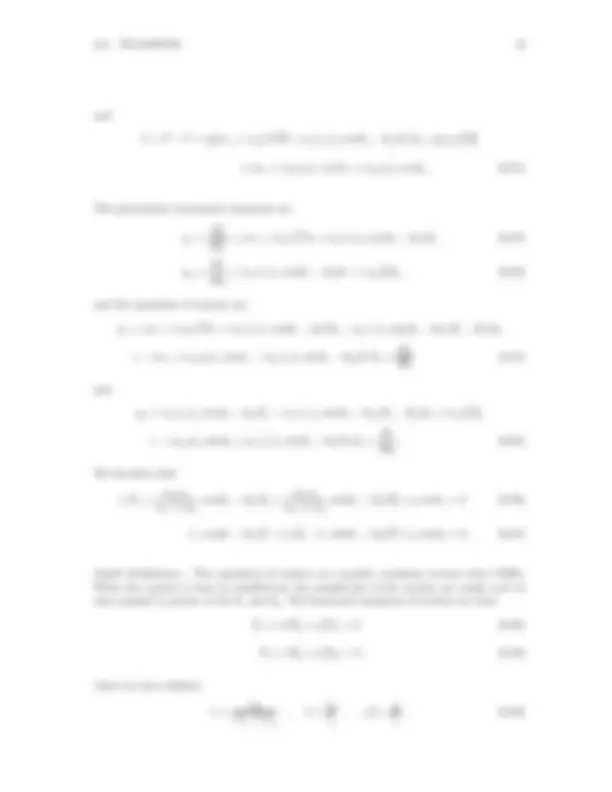
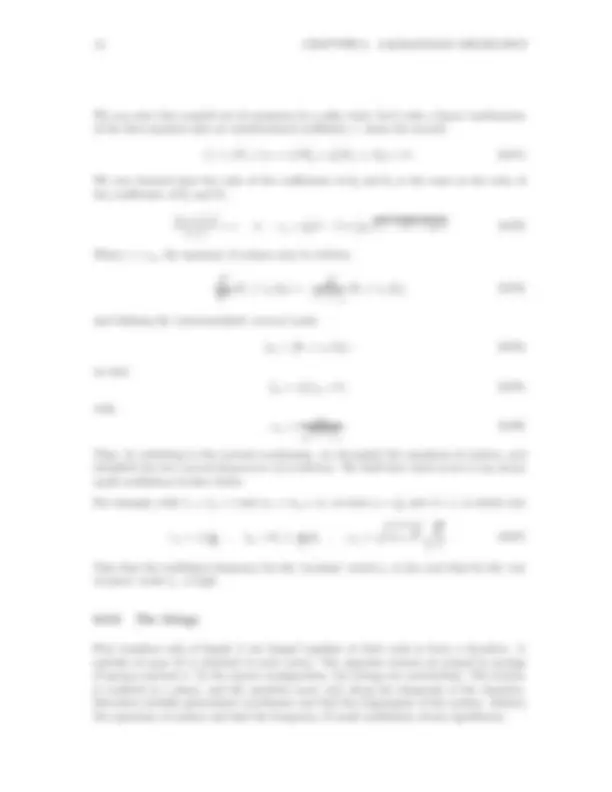
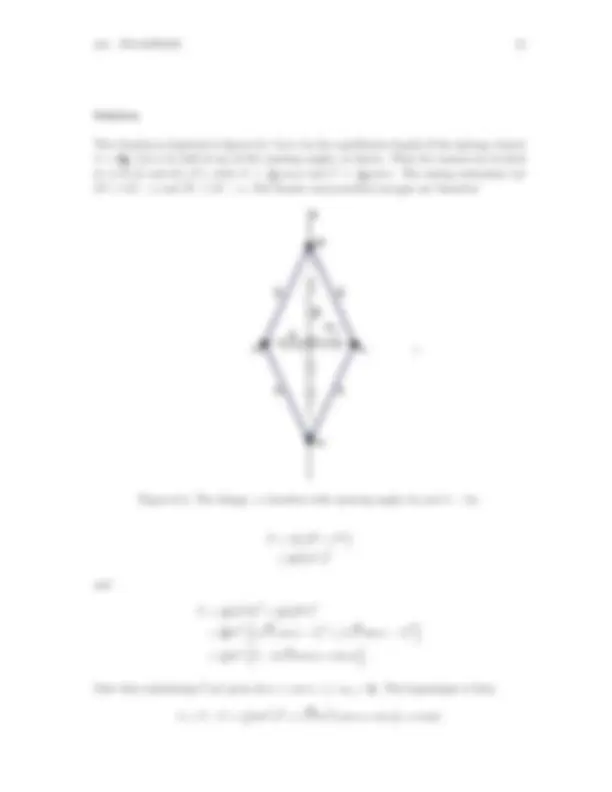


Study with the several resources on Docsity

Earn points by helping other students or get them with a premium plan


Prepare for your exams
Study with the several resources on Docsity

Earn points to download
Earn points by helping other students or get them with a premium plan
Community
Ask the community for help and clear up your study doubts
Discover the best universities in your country according to Docsity users
Free resources
Download our free guides on studying techniques, anxiety management strategies, and thesis advice from Docsity tutors
Lagrangian Mechanics. 6.1 Generalized Coordinates. A set of generalized coordinates q1,...,qn completely describes the positions of all particles.
Typology: Study Guides, Projects, Research
Uploaded on 09/27/2022
1 / 17

This page cannot be seen from the preview
Don't miss anything!










A set of generalized coordinates q 1
,... , q n
completely describes the positions of all particles
in a mechanical system. In a system with d f
degrees of freedom and k constraints, n = d f
−k
independent generalized coordinates are needed to completely specify all the positions. A
constraint is a relation among coordinates, such as x
2
2
2 = a
2 for a particle moving
on a sphere of radius a. In this case, d f
= 3 and k = 1. In this case, we could eliminate z
in favor of x and y, i.e. by writing z = ±
a
2 − x
2 − y
2 , or we could choose as coordinates
the polar and azimuthal angles θ and φ.
For the moment we will assume that n = d f
− k, and that the generalized coordinates are
independent, satisfying no additional constraints among them. Later on we will learn how
to deal with any remaining constraints among the {q 1
,... , q n
The generalized coordinates may have units of length, or angle, or perhaps something totally
different. In the theory of small oscillations, the normal coordinates are conventionally
chosen to have units of (mass)
1 / 2 ×(length). However, once a choice of generalized coordinate
is made, with a concomitant set of units, the units of the conjugate momentum and force
are determined:
p σ
2
q σ
σ
2
2
q σ
where
means ‘the units of A’, and where M , L, and T stand for mass, length, and time,
respectively. Thus, if q σ
has dimensions of length, then p σ
has dimensions of momentum
and F σ
has dimensions of force. If q σ
is dimensionless, as is the case for an angle, p σ
has
dimensions of angular momentum (M L
2 /T ) and F σ
has dimensions of torque (M L
2 /T
2 ).
The equations of motion of classical mechanics are embodied in a variational principle,
called Hamilton’s principle. Hamilton’s principle states that the motion of a system is such
that the action functional
q(t)
t ∫^2
t 1
dt L(q, q, t˙ ) (6.2)
is an extremum, i.e. δS = 0. Here, q = {q 1
,... , q n
} is a complete set of generalized
coordinates for our mechanical system, and
is the Lagrangian, where T is the kinetic energy and U is the potential energy. Setting the
first variation of the action to zero gives the Euler-Lagrange equations,
d
dt
momentum pσ
∂ q˙ σ
force Fσ
∂q σ
Thus, we have the familiar ˙p σ
σ
, also known as Newton’s second law. Note, however,
that the {qσ} are generalized coordinates, so pσ may not have dimensions of momentum,
nor F σ
of force. For example, if the generalized coordinate in question is an angle φ, then
the corresponding generalized momentum is the angular momentum about the axis of φ’s
rotation, and the generalized force is the torque.
Suppose
L(q, q, t˙ ) = L(q, q, t˙ ) +
d
dt
G(q, t). (6.5)
Then
S[q(t)] = S[q(t)] + G(q b
, t b
) − G(q a
, t a
Since the difference
S − S is a function only of the endpoint values {qa, q b
}, their variations
are identical: δ
S = δS. This means that L and
L result in the same equations of motion.
Thus, the equations of motion are invariant under a shift of L by a total time derivative of
a function of coordinates and time.
The equations of motion are second order in time. This follows from the fact that L =
L(q, q, t˙ ). Using the chain rule,
d
dt
∂ q˙σ
2 L
∂ q˙σ ∂ q˙σ′
q ¨ σ
2 L
∂ q˙σ ∂qσ′
q ˙ σ
2 L
∂ q˙σ ∂t
however, as we shall see, velocity-dependent potentials appear in the case of charged parti-
cles interacting with electromagnetic fields. In general, though,
where T is the kinetic energy, and U is the potential energy.
A conserved quantity Λ(q, q, t˙ ) is one which does not vary throughout the motion of the
system. This means
dΛ
dt
q=q(t)
We shall discuss conserved quantities in detail in the chapter on Noether’s Theorem, which
follows.
The simplest case of a conserved quantity occurs when the Lagrangian does not explicitly
depend on one or more of the generalized coordinates, i.e. when
σ
∂q σ
We then say that L is cyclic in the coordinate qσ. In this case, the Euler-Lagrange equations
p˙ σ
σ
say that the conjugate momentum p σ
is conserved. Consider, for example, the
motion of a particle of mass m near the surface of the earth. Let (x, y) be coordinates
parallel to the surface and z the height. We then have
1
2
m
x˙
2
2
2
U = mgz (6.17)
1
2
m
x˙
2
2
2
− mgz. (6.18)
Since
x
∂x
= 0 and F y
∂y
we have that p x
and p y
are conserved, with
p x
∂ x˙
= m x˙ , p y
∂ y˙
= m y .˙ (6.20)
These first order equations can be integrated to yield
x(t) = x(0) +
px
m
t , y(t) = y(0) +
py
m
t. (6.21)
The z equation is of course
p˙ z
= mz¨ = −mg = F z
with solution
z(t) = z(0) + ˙z(0) t −
1
2
gt
2
. (6.23)
As another example, consider a particle moving in the (x, y) plane under the influence of
a potential U (x, y) = U
x
2
2
which depends only on the particle’s distance from
the origin ρ =
x
2
2
. The Lagrangian, expressed in two-dimensional polar coordinates
(ρ, φ), is
1
2
m
ρ˙
2
2 ˙ φ
2
− U (ρ). (6.24)
We see that L is cyclic in the angle φ, hence
p φ
φ
= mρ
2 ˙ φ (6.25)
is conserved. p φ
is the angular momentum of the particle about the ˆz axis. In the language
of the calculus of variations, momentum conservation is what follows when the integrand of
a functional is independent of the independent variable.
When the integrand of a functional is independent of the dependent variable, another con-
servation law follows. For Lagrangian mechanics, consider the expression
H(q, q, t˙ ) =
n ∑
σ=
p σ
q˙ σ
Now we take the total time derivative of H:
dH
dt
n ∑
σ=
p σ
¨q σ
q˙ σ
∂q σ
q ˙ σ
∂ q˙ σ
q ¨ σ
∂t
We evaluate
H along the motion of the system, which entails that the terms in the curly
brackets above cancel for each σ:
p σ
∂ q˙σ
, p˙ σ
∂qσ
Thus, we find
dH
dt
∂t
which means that H is conserved whenever the Lagrangian contains no explicit time depen-
dence. For a Lagrangian of the form
a
1
2
m a
r˙
2
a
− U (r 1
,... , r N
The kinetic energy is
1
2
m
x˙
2
2
2
1
2
m
r˙
2
θ
2
2 sin
2 θ
φ
2
Here are some simple steps you can follow toward obtaining the equations of motion:
,... , q n
L(q, q, t˙ ) = T − U. It is often helpful to first write the kinetic energy in Cartesian
coordinates for each particle before converting to generalized coordinates.
∂L
∂ q˙ σ
and the generalized forces F σ
∂L
∂q σ
and write the equations of motion ˙p σ
σ
. Be careful
to differentiate properly, using the chain rule and the Leibniz rule where appropriate.
For a one-dimensional mechanical system with potential energy U (x),
1
2
m x˙
2 − U (x). (6.40)
The canonical momentum is
p =
∂ x˙
= m x˙ (6.41)
and the equation of motion is
d
dt
∂ x˙
∂x
⇒ mx¨ = −U
′ (x) , (6.42)
which is of course F = ma.
Note that we can multiply the equation of motion by ˙x to get
0 = ˙x
mx¨ + U
′
(x)
d
dt
1
2
m x˙
2
dE
dt
where E = T + U.
Consider next a particle of mass m moving in two dimensions under the influence of a
potential U (ρ) which is a function of the distance from the origin ρ =
x
2
2
. Clearly
cylindrical (2d polar) coordinates are called for:
1
2
m
ρ˙
2
2 ˙ φ
2
− U (ρ). (6.44)
The equations of motion are
d
dt
∂ ρ˙
∂ρ
⇒ mρ¨ = mρ
φ
2 − U
′ (ρ) (6.45)
d
dt
φ
∂φ
d
dt
mρ
2 ˙ φ
Note that the canonical momentum conjugate to φ, which is to say the angular momentum,
is conserved:
p φ
= mρ
φ = const. (6.47)
We can use this to eliminate
φ from the first Euler-Lagrange equation, obtaining
mρ¨ =
p
2
φ
mρ
3
′ (ρ). (6.48)
We can also write the total energy as
1
2
m
ρ˙
2
φ
2
1
2
m ρ˙
2
p
2
φ
2 mρ
2
from which it may be shown that E is also a constant:
dE
dt
m ρ¨ −
p
2
φ
mρ
3
′ (ρ)
ρ ˙ = 0. (6.50)
We shall discuss this case in much greater detail in the coming weeks.
Consider the situation depicted in Fig. 6.1, in which a point object of mass m slides
frictionlessly along a wedge of opening angle α. The wedge itself slides frictionlessly along a
horizontal surface, and its mass is M. We choose as generalized coordinates the horizontal
position X of the left corner of the wedge, and the horizontal distance x from the left corner
to the sliding point mass. The vertical coordinate of the sliding mass is then y = x tan α,
Figure 6.2: The spring–pendulum system.
Consider next the system depicted in Fig. 6.2 in which a mass M moves horizontally while
attached to a spring of spring constant k. Hanging from this mass is a pendulum of arm
length ℓ and bob mass m.
A convenient set of generalized coordinates is (x, θ), where x is the displacement of the mass
M relative to the equilibrium extension a of the spring, and θ is the angle the pendulum
arm makes with respect to the vertical. Let the Cartesian coordinates of the pendulum bob
be (x 1
, y 1
). Then
x 1
= a + x + ℓ sin θ , y 1
= −l cos θ. (6.57)
The kinetic energy is
1
2
M x˙
2
1
2
m ( ˙x
2
2
)
1
2
M x˙
2
1
2
m
( ˙x + ℓ cos θ
θ)
2
θ)
2
1
2
(M + m) ˙x
2
1
2
mℓ
2 ˙ θ
2
θ , (6.58)
and the potential energy is
1
2
kx
2
1
2
kx
2 − mgℓ cos θ. (6.59)
Thus,
1
2
(M + m) ˙x
2
1
2
mℓ
2 ˙ θ
2
θ −
1
2
kx
2
The canonical momenta are
p x
∂ x˙
= (M + m) ˙x + mℓ cos θ
θ
p θ
θ
= mℓ cos θ x˙ + mℓ
θ , (6.61)
and the canonical forces are
x
∂x
= −kx
θ
∂θ
= −mℓ sin θ x˙
θ − mgℓ sin θ. (6.62)
The equations of motion then yield
(M + m) ¨x + mℓ cos θ
θ − mℓ sin θ
θ
2
= −kx (6.63)
mℓ cos θ ¨x + mℓ
θ = −mgℓ sin θ. (6.64)
Small Oscillations : If we assume both x and θ are small, we may write sin θ ≈ θ and
cos θ ≈ 1, in which case the equations of motion may be linearized to
(M + m) ¨x + mℓ
θ + kx = 0 (6.65)
mℓ x¨ + mℓ
2 ¨ θ + mgℓ θ = 0. (6.66)
If we define
u ≡
x
, α ≡
m
, ω
2
0
k
, ω
2
1
g
then
(1 + α) ¨u + α
θ + ω
2
0
u = 0 (6.68)
u¨ +
θ + ω
2
1
θ = 0. (6.69)
We can solve by writing (
u(t)
θ(t)
a
b
e
−iωt
, (6.70)
in which case (
ω
2
0
− (1 + α) ω
2 −α ω
2
−ω
2 ω
2
1
− ω
2
a
b
In order to have a nontrivial solution (i.e. without a = b = 0), the determinant of the above
2 × 2 matrix must vanish. This gives a condition on ω
2 , with solutions
ω
2
±
1
2
ω
2
0
2
1
1
2
ω
2
0
− ω
2
1
2
2
0
2
1
) ω
2
1
and
1
2
(m 1
2
1
θ
2
1
1
2
cos(θ 1
− θ 2
θ 1
θ 2
1
2
m 2
2
2
θ
2
2
(m 1
m 2
) g ℓ 1
cos θ 1 + m 2
g ℓ 2
cos θ 2
The generalized (canonical) momenta are
p 1
θ 1
= (m 1
2
1
θ 1
1
2
cos(θ 1
− θ 2
θ 2
p 2
θ 2
= m 2
1
2
cos(θ 1
− θ 2
θ 1
2
2
θ 2
and the equations of motion are
p˙ 1
= (m 1
2
1
θ 1 + m 2
1
2
cos(θ 1
− θ 2
θ 2
− m 2
1
2
sin(θ 1
− θ 2
θ 1
θ 2
θ 2
= −(m 1
) g ℓ 1
sin θ 1
− m 2
1
2
sin(θ 1
− θ 2
θ 1
θ 2
∂θ 1
and
p˙ 2
= m 2
1
2
cos(θ 1
− θ 2
θ 1
− m 2
1
2
sin(θ 1
− θ 2
θ 1
θ 2
θ 1
2
2
θ 2
= −m 2
g ℓ 2
sin θ 2
1
2
sin(θ 1
− θ 2
θ 1
θ 2
∂θ 2
We therefore find
1
θ 1
m 2
2
m 1 + m 2
cos(θ 1
− θ 2
θ 2
m 2
2
m 1 + m 2
sin(θ 1
− θ 2
θ
2
2
1
cos(θ 1
− θ 2
θ 1 + ℓ 2
θ 2
1
sin(θ 1
− θ 2
θ
2
1
Small Oscillations : The equations of motion are coupled, nonlinear second order ODEs.
When the system is close to equilibrium, the amplitudes of the motion are small, and we
may expand in powers of the θ 1
and θ 2
. The linearized equations of motion are then
θ 1
θ 2
2
0
θ 1
θ 1
θ 2
2
0
θ 2
where we have defined
α ≡
m 2
m 1
, β ≡
2
1
, ω
2
0
g
1
We can solve this coupled set of equations by a nifty trick. Let’s take a linear combination
of the first equation plus an undetermined coefficient, r, times the second:
(1 + r)
θ 1
θ 2
2
0
(θ 1
We now demand that the ratio of the coefficients of θ 2
and θ 1
is the same as the ratio of
the coefficients of
θ 2
and
θ 1
(α + r) β
1 + r
= r ⇒ r ±
1
2
(β − 1) ±
1
2
(1 − β)
2
When r = r ±
, the equation of motion may be written
d
2
dt
2
θ 1
θ 2
ω
2
0
1 + r ±
θ 1
θ 2
and defining the (unnormalized) normal modes
ξ ±
θ 1
θ 2
we find
ξ ±
2
±
ξ ±
with
ω ±
ω 0
√
1 + r ±
Thus, by switching to the normal coordinates, we decoupled the equations of motion, and
identified the two normal frequencies of oscillation. We shall have much more to say about
small oscillations further below.
For example, with ℓ 1
2
= ℓ and m 1
= m 2
= m, we have α =
1
2
, and β = 1, in which case
r ±
1 √
2
, ξ ±
= θ 1
1 √
2
θ 2
, ω ±
g
Note that the oscillation frequency for the ‘in-phase’ mode ξ
is low, and that for the ‘out
of phase’ mode ξ −
is high.
Four massless rods of length L are hinged together at their ends to form a rhombus. A
particle of mass M is attached to each vertex. The opposite corners are joined by springs
of spring constant k. In the square configuration, the strings are unstretched. The motion
is confined to a plane, and the particles move only along the diagonals of the rhombus.
Introduce suitable generalized coordinates and find the Lagrangian of the system. Deduce
the equations of motion and find the frequency of small oscillations about equilibrium.
The equations of motion are
d
dt
φ
∂φ
⇒ M a
2 ¨ φ =
2 ka
2
(cos φ − sin φ)
It’s always smart to expand about equilibrium, so let’s write φ =
π
4
δ + ω
2
0
sin δ = 0 ,
with ω 0
2 k/M. This is the equation of a pendulum! Linearizing gives
δ + ω
2
0
δ = 0, so
the small oscillation frequency is just ω 0
The virial theorem is a statement about the time-averaged motion of a mechanical system.
Define the virial,
G(q, p) =
σ
p σ
q σ
Then
dG
dt
σ
p˙ σ
q σ
q˙ σ
σ
q σ
σ
σ
q ˙ σ
∂ q˙σ
Now suppose that T =
1
2
σ,σ
σσ
′
q˙ σ
q˙ σ
′
is homogeneous of degree k = 2 in ˙q, and that U
is homogeneous of degree zero in ˙q. Then
σ
q ˙ σ
∂ q˙ σ
σ
q ˙ σ
∂ q˙ σ
which follows from Euler’s theorem on homogeneous functions.
Now consider the time average of
G over a period τ :
dG
dt
τ
τ ∫
0
dt
dG
dt
τ
G(τ ) − G(0)
If G(t) is bounded, then in the limit τ → ∞ we must have 〈
G〉 = 0. Any bounded motion,
such as the orbit of the earth around the Sun, will result in 〈
τ →∞
= 0. But then
dG
dt
σ
q σ
σ
which implies
1
2
σ
q σ
σ
1
2
σ
q σ
∂q σ
1
2
i
r i
i
r 1
,... , r N
1
2
k 〈U 〉 , (6.104)
where the last line pertains to homogeneous potentials of degree k. Finally, since T +U = E
is conserved, we have
k E
k + 2
k + 2